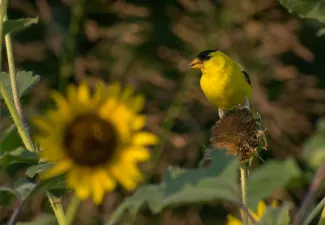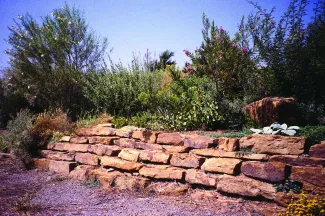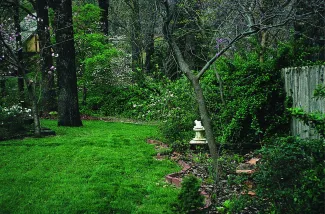Creating a successful wildscape is comparable to baking a cake – you may be able to bake what appears to be an appetizing treat, but without all the right ingredients, it just won’t taste the same. Successful wildscapes likewise involve certain necessary ingredients. You may have wildlife visiting your yard, but unless you meet their sometimes-unique food, water, cover, and space requirements, they won’t live in your wildscape.
Plants play an important role in providing these requirements because a well-planned landscape, or wildscape, can create the habitat that wild creatures need to eat, rest, raise young, and find protection. A diverse landscape with many plant species supports an abundance of wildlife. Many more wildlife species will visit a small or average-sized yard with high habitat diversity than will visit a yard with a large expanse of manicured lawn.
Wildscape Ingredient: Food

American goldfinch.
Many animal’s food requirements vary seasonally due to different energy demands. Breeding, migration, and inclement weather are taxing on wildlife and can change their food needs. The ideal wildscape supplies food all year – from the earliest summer berries to fruits that persist through winter and spring. Supplemental feeding during the year is another alternative, although it is probably more important for humans because it brings wild visitors closer, where they can be viewed more easily.
Variety is the rule for adding feeding stations to your wildscape. By placing different types of feeders in various locales, you’ll see a wider diversity of birds and other wildlife visiting your wildscape. You’ll also notice that some species strongly prefer certain foods over others. However, the only way to increase your local wildlife populations permanently is to provide a habitat rich in diversity.
Wildscape Ingredient: Water

Blue jay.
Most animals need water to drink and bathe, but fish and amphibians such as frogs and salamanders need water to complete their life cycle. Migratory birds are also attracted to water as they rest during their long flights in fall and spring. Lack of fresh water is the factor most often limiting the wildlife that will visit yards.
One of the best ways to bring birds and other wildlife to your wildscape is by providing a clean, dependable water source year-round. Water sources could include a natural stream, birdbath, small pond, or recirculating stream. Clean water in close proximity to protective cover will make your yard even more attractive to animals. In fact, especially during spring and fall migrations and the hot summer months, a predator-safe birdbath will attract bird species that seldom visit feeders.
Another way to provide water is to construct a circulating stream with small holding ponds. Besides attracting birds and mammals, such a backyard stream and its accompanying ponds would also provide a habitat for amphibians and fish.
Wildscape Ingredient: Cover

Rock gardens can provide shelter, food, and basking areas for lizards and butterflies.
Wild animals need cover, or shelter, to protect them from predators and adverse weather. Traveling, resting, feeding, and breeding make individuals vulnerable, so they will stay clear of a yard that does not provide them with protective cover for these activities. Many trees and plants do double duty, providing both cover and food for wildlife.
Planting native trees, shrubs, vines, and flowers will create sources of cover and shelter. In developing your planting strategy, keep several concepts in mind. Vertical layering of plants will stretch from ground cover to shrubs to medium trees to an upper canopy, providing different layers where wildlife can live. Horizontal layering involves planting several overlapping rows of trees and shrubs, providing a greenbelt within which wildlife can travel safely from one area to another. Finally, implement curving edges into your wildscape to mimic natural habitats more closely; nowhere in nature will you find a straight line that separates one habitat type from another.
Unfortunately, even the best wildscape design takes time to develop. While waiting for your trees and shrubs to grow taller and expand, you can create other cover sources. These sources are especially important in the beginning wildscape, when trees are small and ground cover hasn’t been established.
The beginning wildscape can include a brush pile to provide safety from predators and the weather for all species of ground-feeding birds and for a variety of mammals and reptiles. Build a brush pile where vegetation is scarce by laying four logs on the ground parallel to one another and about 8 to 12 inches apart. Then place four similar logs perpendicular across the first four, which will keep tunnels open under the pile. Next, add large limbs and then smaller branches until you have created a structure 4 to 6 feet in height and diameter. Sticks and branches can then be added to the top as the pile rots at the bottom, which provides food for earthworms and grubs, further enriching the soil. If you want a brush pile for birds to use, but not rabbits, pile brush one or two feet off the ground on cement blocks. To make the pile more attractive, plant native honeysuckle or climbing roses around the base.
Another thing that can be attempted in your wildscape is the construction of rock walls or rock piles. These provide shelter for chipmunks, rabbits, and other small mammals to raise their young. Lizards and frogs use them for cover and sunbathing spots, especially if such rock features are created along the edges of ponds. Butterflies use scattered, light-colored stones as morning basking sites.
Rock walls can be created by stacking field stone about 3 feet high; make sure that it has plenty of spaces and cavities where wildlife can hide and perch. To build a rock pile, lay several large, rounded rocks in a spoke-wheel pattern to form the base. Use pieces of chimney tile or PVC pipe to create tunnels, and then add flattened rocks on top to create sheltered spots.
After your wildscape has grown for several years, you might be able to provide snags, stumps or fallen logs. These habitat elements provide excellent cover, nesting areas, food, storage, and places to perch, rest, and hibernate. Where it is safe to do so, leave large dead trees standing or shorten them to create stumps.
By leaving some deep leaf litter under your shrubs and trees, you create a ground cover that contains insects eaten by wrens, lizards, salamanders, toads, and frogs. The gray treefrog is just one species that hibernates in deep leaf litter.
Wildscape Ingredient: Space

Finally, animals require a certain amount of space to mate and rear their young. Some species, such as bluebirds and woodpeckers, are territorial and require more space than others. Landowners with several acres will be able to attract more wildlife than will someone with a smaller lot, which may only be able to support one or two pairs of breeding animals. However, wildlife may require less space where food, water, and shelter are close together.
The types of wildlife present will depend on the structure and vertical distribution of the vegetation. Humans think of space on a horizontal scale, but birds also divide habitat into vertical layers, each species feeding in a different way at a different height. The greater the vertical distribution of vegetation, the more species can be accommodated. Maintaining woods at different stages of succession is the primary means of providing vertical diversity, but this may not be possible if your woodlot is a small one.
Identify Your Target Wildlife Species
The numbers and kinds of animals that may visit your yard depend upon how suitable a habitat you create for them. The more closely your property mimics the natural conditions where the animals are found, the better your chances of attracting them. Each wildlife species has specific requirements that may change seasonally and over its life cycle. The more you know about the food, water, space, and cover requirements of the species you favor, the greater the likelihood of successfully persuading them into your yard.
Before you begin the process of making your property more attractive to wildlife, consult with your neighbors regarding their feelings toward wildlife in general. City ordinances may also restrict what you can do to your yard.
This content originally appeared in the Wildlife Department’s “Landscaping for Wildlife” guide. The full guide can be viewed here.